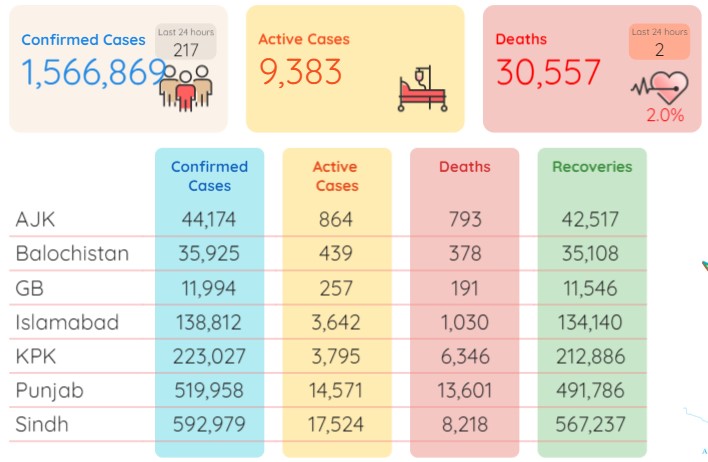Pakistan records a dip in coronavirus infections, fatalities
NIH data shows infectivity rate plunges below 2 : Covid infectiousness lasts for more than 5 days, finds new study: Philippine schools reopen after more than two years
August 23, 2022 11:05 AM

Pakistan has recorded a dip in the number of daily coronavirus infections and fatalities as the country reported 217 coronavirus infections and two deaths during the last 24 hours (Monday), showed the statistics released by the National Institute of Health Pakistan on Tuesday morning, reported 24NewsHD TV channel.
As per the NIH data, the death toll in the country now surged to 30,557 after adding the two new deaths while the number of total infections now stood at 1,566,869 after adding the fresh 217 cases.
During the last 24 hours (Monday), 12,285 tests were conducted throughout Pakistan whereas the positivity ratio stood at 1.92 percent. The number of patients in critical care was recorded at 116.
https://twitter.com/NIH_Pakistan/status/1561891857969324032
During the last 24 hours (Monday), another 369 patients have recovered from the Covid-19 in Pakistan and the number of total recoveries now stood at 1,526,929. As of Tuesday, the total count of active cases in the country was recorded at 9,383.
As many as 592,979 coronavirus cases have so far been confirmed in Sindh, 519,958 in Punjab, 223,027 in Khyber Pakhtunkhwa, 138,812 in Islamabad, 35,925 in Balochistan, 44,174 in Azad Kashmir and 11,994 in Gilgit-Baltistan.
As many as 13,601 individuals have lost their lives to the pandemic in Punjab so far, 8,218 in Sindh, 6,346 in KP, 1,030 in Islamabad, 793 in Azad Kashmir, 378 in Balochistan and 191 in Gilgit Baltistan.

Covid infectiousness lasts for more than 5 days, finds new study
A new research study has shed light on the duration of Covid infection and the time till which a person remains infectious. The study done by Imperial College London scientists provides an insight on how long people with COVID are actually infectious. "The study is the first real-world evidence of this kind," it says.
Omicron is currently the dominant strain of the virus that is driving the majority of the infection worldwide.
What is the new research study about?
The new research study by the Imperial College London is about determining the infectious nature of the COVID infection with special emphasis on Omicron led infection which mostly shows mild symptoms.
The study is said to be the first to figure out how long infectiousness lasts in COVID infection. "The study team conducted detailed daily tests from when people were exposed to SARS-CoV-2 to look at how much infectious virus they were shedding throughout their infection," the study report says.
The study is based on 57 participants. "It may not apply to very young and old people, or those with medical conditions. This is because children are thought to clear the virus more quickly, while older people and those with medical conditions may be slower at clearing the virus," reads the research report.
What did the study find?
The study found that of the total number of participants, two-thirds of cases were still infectious five days after their symptoms began, and one-quarter were still infectious at seven days.
It also found that only one in five participants were infectious before symptom onset, so most people only became infectious after they developed symptoms.
So how many days should a person remain in self-isolation?
On the duration of the self isolation period, the researchers say, people can complete lateral flow tests on days six and seven and can leave isolation only if the tests are negative.
"If a person continues to test positive on day six or beyond, or does not have access to lateral flow tests, we think they should remain in isolation until they’ve had two consecutive days with negative test results," says study author, Professor Ajit Lalvani, Director of the NIHR Respiratory Infections Health Protection Research Unit at Imperial.
The research protocol
The participants were monitored in their homes from the day when they were first exposed to the virus, the day when they developed infection till the day they stopped showing signs of infection.
"By using special daily tests to measure infectious virus (not just PCR) and daily symptom records we were able to define the window in which people are infectious. This is fundamental to controlling any pandemic and has not been previously defined for any respiratory infection in the community,” says Professor Lalvani.
Participants completed daily questionnaires about their symptoms and did daily nasal and throat swabs that were sent to a laboratory for PCR-testing.
Though 57 participants had enrolled for the study, the duration of infectiousness was measured in 42 people due to several reasons like some of the participants did not share any information, and some did not shed culturable virus, the study says.
Lateral flow test
The study suggests that lateral flow tests do not detect the start of infectiousness well, they more accurately identify when someone is no longer infectious and can safely leave isolation.
The researchers carried out 652 lateral flow tests to determine its accuracy in comparison to PCR tests.
Lateral flow tests include taking samples from the throat and nose or nose only using a swab. Depending on the type of test, one can get the result within 10-30 minutes.
The bottom line
The infected individual's infectiousness is a big factor in COVID transmission. With the pandemic nowhere near over, it is important to know about the infectiousness and the duration of self isolation.
“Self-isolation is not necessary by law, but people who want to isolate need clear guidance on what to do. The NHS currently advises that if you test positive for COVID-19 you should try to stay at home and avoid contact with other people for five days, but our data suggest that under a crude five-day self-isolation period two-thirds of cases released into the community would still be infectious – though their level of infectiousness would have substantially reduced compared to earlier in the course of their infection,” says Professor Lalvani.
"We recommend that anyone who has been exposed to the virus and has symptoms isolates for five days, then uses daily lateral flow tests to safely leave isolation when two consecutive daily tests are negative," he suggests.
Philippine classrooms reopen after more than two years
Millions of children in the Philippines returned to school as the academic year started on Monday, with many taking their seats in classrooms for the first time since the Covid-19 pandemic hit.
The Philippines is one of the last countries in the world to resume full-time, in-person lessons -- sparking warnings that the prolonged closure of classrooms had worsened an education crisis in the country.
Children in masks and uniforms lined up for a temperature check and squirt of hand sanitiser at Pedro Guevara Elementary School in Manila, which had shut classrooms since March 2020.
The school has adopted a hybrid system of in-person and remote learning as it transitions its nearly 6,000 students back to face-to-face classes by November -- a deadline set by President Ferdinand Marcos Jr soon after he took office two months ago.
Grade six student Sophia Macahilig said she was "excited" to meet her classmates and teachers after two years of Zoom lessons.
"We used to have fun and now I can have fun again," 11-year-old Macahilig told AFP.
But many students have a lot of catching up to do.
Even before the pandemic, nine out of 10 Filipino children could "not read a simple text with comprehension" by age 10, the World Bank and other agencies said in a recent report.
Only 10 countries were worse off, including Afghanistan, Laos, Chad and Yemen.
- Lagging behind -
After Philippine schools closed, a "blended learning" programme involving online classes, printed materials and lessons broadcast on television and social media was introduced.
As face-to-face classes resume, old problems persist: large class sizes, outdated teaching methods, poverty, and lack of basic infrastructure -- such as toilets -- have been blamed for contributing to the education crisis.
Pedro Guevara science teacher Ethel Tumanan, 32, said she was worried that students had missed out on valuable learning over the past two years.
"As a teacher, we really prefer face-to-face, at least we are the ones who can gauge and assess where our pupils are at."
In the lead-up to the reopening of classrooms, the government has been ramping up a vaccination drive and will provide students with free public transport until the end of the calendar year.
On Saturday, the government began handing out cash aid to students and parents struggling to cover expenses, leading to chaotic scenes outside distribution centres.
In the city of Zamboanga, 29 people were injured when several thousand tried to push through the gate of a high school.
With inputs from AFP.




 Yet another burden on people: Govt hikes oil prices
Yet another burden on people: Govt hikes oil prices Public reacts to Bohemia's music video ‘Salsa’ starring Sistrology
Public reacts to Bohemia's music video ‘Salsa’ starring Sistrology Saudis offered PIA, airports, joint ventures to build five-star hotels
Saudis offered PIA, airports, joint ventures to build five-star hotels Finance minister rules out further rupee devaluation
Finance minister rules out further rupee devaluation Post-mortem report says woman’s death caused by her falling off train
Post-mortem report says woman’s death caused by her falling off train Hamari Mulaqat: Bushra Ansari opens up about divorce and 2nd marriage to Iqbal Hussain
Hamari Mulaqat: Bushra Ansari opens up about divorce and 2nd marriage to Iqbal Hussain





